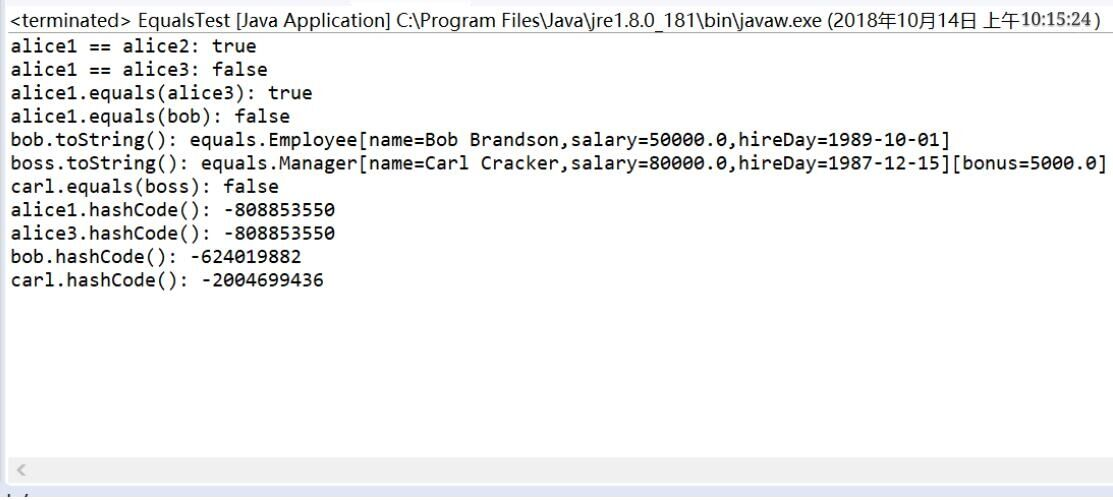第一部分:理论知识
1.访问修饰符:private,protected,public,默认
使用访问修饰符的原因:实现受限信息隐藏。
信息隐藏目的: 对类中任何实现细节的更改不会影响使用该类的代码,防止用户意外删除数据,易于使用类。
public:该类或非该类均可访问
private:只有该类可以访问
protected:该类及其子类的成员可以访问,同一个包中的类也可访问
默认:相同包中的类可以访问
2.Object:所有类的超类
Object类是Java中所有类的祖先——每一个类都由它扩 展而来。在不给出超类的情况下,Java会自动把Object 作为要定义类的超类。
可以使用类型为Object的变量指向任意类型的对象。但 要对它们进行专门的操作都要进行类型转换。
3.ArrayList
ArrayList 对象=new ArrayList(); 例:ArrayList staff =new ArrayList();
API:ArrayList 的构造器 – ArrayList()构造一个空数组列表 – ArrayList(int initialCapacity)构造一个具有 指定容量的空数组列表
添加新元素 API:boolean add(T obj) 把元素obj追加到数组列表的结尾 例:staff.add(new Employee(…));
统计个数 API:int size() 返回数组列表中当前元素个数 例:staff.size();
调整大小 API:void trimToSize() 把数组列表的存贮空间调整到当前大小
访问 API:void set(int index, T obj) 将obj放入数组列表index位置,将覆盖这 个位置的原有内容。 API:T get(int index) 获得指定位置index的元素值 例:Employee harry = new Employee(…); staff.set(1, harry); Employee e = staff.get(1);
增加与删除 API:boolean add(int index, T obj) 向后移动元素,在第n 个位置插入obj API:T remove(int index); 将第n个位置存放的对象删除,并将后面的 元素向前移动 例:staff.add(i,harry); Employee e = staff.remove(i);
10.枚举类
声明枚举类 public enum Grade { A, B, C, D, E };
它包括一个关键字enum,一个新枚举类型的名字 Grade以及为Grade定义的一组值。
11.抽象类
一个类一定被定义成抽象类,他就是一个专职父类。不能实例化,即不能创建对象,只能产生子类。
第二部分:实验部分
1、实验目的与要求
(1)进一步理解4个成员访问权限修饰符的用途;
(2)掌握Object类的常用API用法;
(3)掌握ArrayList类用法与常用API;
(4)掌握枚举类使用方法;
(5)结合本章知识,理解继承与多态性两个面向对象程序设计特征,并体会其优点;
(6)熟练掌握Java语言中基于类、继承技术构造程序的语法知识(ch1-ch5);
(7)利用已掌握Java语言程序设计知识,学习设计开发含有1个主类、2个以上用户自定义类的应用程序。
2、实验内容和步骤
实验1 补充以下程序中主类内main方法体,以验证四种权限修饰符的用法。
1 public class Test { 2 private String t1 = "这是 Test 的私有属性"; 3 public String t2 = "这是Test的公有属性"; 4 protected String t3 = "这是Test受保护的属性"; 5 String t4 = "这是Test的默认属性"; 6 private void tese1() { 7 System.out.println("我是Test用private修饰符修饰的方法"); 8 } 9 public void tese2() {10 System.out.println("我是Test用public修饰符修饰的方法");11 }12 protected void tese3() {13 System.out.println("我是Test用protected修饰符修饰的方法");14 }15 void tese4() {16 System.out.println("我是Test无修饰符修饰的方法");17 }18 }19 public class Test2 extends Test{20 private String e1 = "这是Test2的私有属性";21 public String e2 = "这是Test2的公有属性";22 protected String e3 = "这是Test2受保护的属性";23 String e4 = "这是Test2的默认属性";24 public void demo1() {25 System.out.println("我是Test2用public修饰符修饰的方法");26 }27 private void demo2() {28 System.out.println("我是Test2用private修饰符修饰的方法");29 }30 protected void demo3() {31 System.out.println("我是Test2用protected修饰符修饰的方法");32 }33 void demo4() {34 System.out.println("我是Test2无修饰符修饰的方法");35 }36 }37 public class Main {38 public static void main(String[] args) {39 Test2 test= new Test2();40 /*以下设计代码分别调用 demo1 demo2 demo3 demo4 test1 test2 test3 test4方法和t1 t2 t3 t3 e1 e2 e3 e4属性,结合程序运行结果理解继承和权限修饰符的用法与区别*/41 42 test.demo1();43 test.demo3();44 test.demo4();45 46 test.tese2();47 test.tese3();48 test.tese4();49 50 System.out.println(test.t2);51 System.out.println(test.t3);52 System.out.println(test.t4);53 System.out.println(test.e2);54 System.out.println(test.e3);55 System.out.println(test.e4);56 }57 } 结果:

实验2 第五章测试程序反思,继承知识总结。
测试程序1:
Ÿ 编辑、编译、调试运行教材程序5-8、5-9、5-10(教材174页-177页);
Ÿ 结合程序运行结果,理解程序代码,掌握Object类的定义及用法;
代码:
package equals;import java.time.*;import java.util.Objects;public class Employee{ private String name; private double salary; private LocalDate hireDay; public Employee(String name, double salary, int year, int month, int day) { this.name = name; this.salary = salary; hireDay = LocalDate.of(year, month, day); } public String getName() { return name; } public double getSalary() { return salary; } public LocalDate getHireDay() { return hireDay; } public void raiseSalary(double byPercent) { double raise = salary * byPercent / 100; salary += raise; } public boolean equals(Object otherObject) { // a quick test to see if the objects are identical if (this == otherObject) return true; // must return false if the explicit parameter is null if (otherObject == null) return false; // if the classes don't match, they can't be equal if (getClass() != otherObject.getClass()) return false; // now we know otherObject is a non-null Employee Employee other = (Employee) otherObject; // test whether the fields have identical values return Objects.equals(name, other.name) && salary == other.salary && Objects.equals(hireDay, other.hireDay); } public int hashCode() { return Objects.hash(name, salary, hireDay); } public String toString() { return getClass().getName() + "[name=" + name + ",salary=" + salary + ",hireDay=" + hireDay + "]"; }} package equals;/** * This program demonstrates the equals method. * @version 1.12 2012-01-26 * @author Cay Horstmann */public class EqualsTest{ public static void main(String[] args) { Employee alice1 = new Employee("Alice Adams", 75000, 1987, 12, 15); Employee alice2 = alice1; Employee alice3 = new Employee("Alice Adams", 75000, 1987, 12, 15); Employee bob = new Employee("Bob Brandson", 50000, 1989, 10, 1); System.out.println("alice1 == alice2: " + (alice1 == alice2)); System.out.println("alice1 == alice3: " + (alice1 == alice3)); System.out.println("alice1.equals(alice3): " + alice1.equals(alice3)); System.out.println("alice1.equals(bob): " + alice1.equals(bob)); System.out.println("bob.toString(): " + bob); Manager carl = new Manager("Carl Cracker", 80000, 1987, 12, 15); Manager boss = new Manager("Carl Cracker", 80000, 1987, 12, 15); boss.setBonus(5000); System.out.println("boss.toString(): " + boss); System.out.println("carl.equals(boss): " + carl.equals(boss)); System.out.println("alice1.hashCode(): " + alice1.hashCode()); System.out.println("alice3.hashCode(): " + alice3.hashCode()); System.out.println("bob.hashCode(): " + bob.hashCode()); System.out.println("carl.hashCode(): " + carl.hashCode()); }} package equals;public class Manager extends Employee{ private double bonus; public Manager(String name, double salary, int year, int month, int day) { super(name, salary, year, month, day); bonus = 0; } public double getSalary() { double baseSalary = super.getSalary(); return baseSalary + bonus; } public void setBonus(double bonus) { this.bonus = bonus; } public boolean equals(Object otherObject) { if (!super.equals(otherObject)) return false; Manager other = (Manager) otherObject; // super.equals checked that this and other belong to the same class return bonus == other.bonus; } public int hashCode() { return java.util.Objects.hash(super.hashCode(), bonus); } public String toString() { return super.toString() + "[bonus=" + bonus + "]"; }} 结果:

测试程序2:
Ÿ 编辑、编译、调试运行教材程序5-11(教材182页);
Ÿ 结合程序运行结果,理解程序代码,掌握ArrayList类的定义及用法;
代码:
package arrayList;import java.util.*;/** * This program demonstrates the ArrayList class. * @version 1.11 2012-01-26 * @author Cay Horstmann */public class ArrayListTest{ public static void main(String[] args) { // fill the staff array list with three Employee objects ArrayList staff = new ArrayList<>(); staff.add(new Employee("Carl Cracker", 75000, 1987, 12, 15)); staff.add(new Employee("Harry Hacker", 50000, 1989, 10, 1)); staff.add(new Employee("Tony Tester", 40000, 1990, 3, 15)); // raise everyone's salary by 5% for (Employee e : staff) e.raiseSalary(5); // print out information about all Employee objects for (Employee e : staff) System.out.println("name=" + e.getName() + ",salary=" + e.getSalary() + ",hireDay=" + e.getHireDay()); }}
package arrayList;import java.time.*;public class Employee{ private String name; private double salary; private LocalDate hireDay; public Employee(String name, double salary, int year, int month, int day) { this.name = name; this.salary = salary; hireDay = LocalDate.of(year, month, day); } public String getName() { return name; } public double getSalary() { return salary; } public LocalDate getHireDay() { return hireDay; } public void raiseSalary(double byPercent) { double raise = salary * byPercent / 100; salary += raise; }} 结果:

测试程序3:
Ÿ 编辑、编译、调试运行程序5-12(教材189页);
Ÿ 结合运行结果,理解程序代码,掌握枚举类的定义及用法;
代码:
package enums;import java.util.*;/** * This program demonstrates enumerated types. * @version 1.0 2004-05-24 * @author Cay Horstmann */public class EnumTest{ public static void main(String[] args) { Scanner in = new Scanner(System.in); System.out.print("Enter a size: (SMALL, MEDIUM, LARGE, EXTRA_LARGE) "); String input = in.next().toUpperCase(); Size size = Enum.valueOf(Size.class, input); System.out.println("size=" + size); System.out.println("abbreviation=" + size.getAbbreviation()); if (size == Size.EXTRA_LARGE) System.out.println("Good job--you paid attention to the _."); }}enum Size{ SMALL("S"), MEDIUM("M"), LARGE("L"), EXTRA_LARGE("XL"); private Size(String abbreviation) { this.abbreviation = abbreviation; } public String getAbbreviation() { return abbreviation; } private String abbreviation;} 结果:

实验3:采用个人账号登录完成《2018秋季西北师范大学面向对象程序设计(Java)(ch1-ch5)测试题2》,测试时间60分钟;
实验4: 课后完成实验3未完成的测试内容。
实验总结:
通过这一周的学习,我深入理解OO程序设计的特征:继承、多态;并且开始慢慢掌握Java语言中基于类、继承技术构造程序的语法知识。并且在这次试验中我感受到了继承的便利性,继承最大的特点就是代码重用,使代码变得简洁,这次实验还使我学会了枚举类使用方法,总之收获很大。同时我也认识到在之后的学习中要更加努力,才能充分学习和消化掉所学知识。